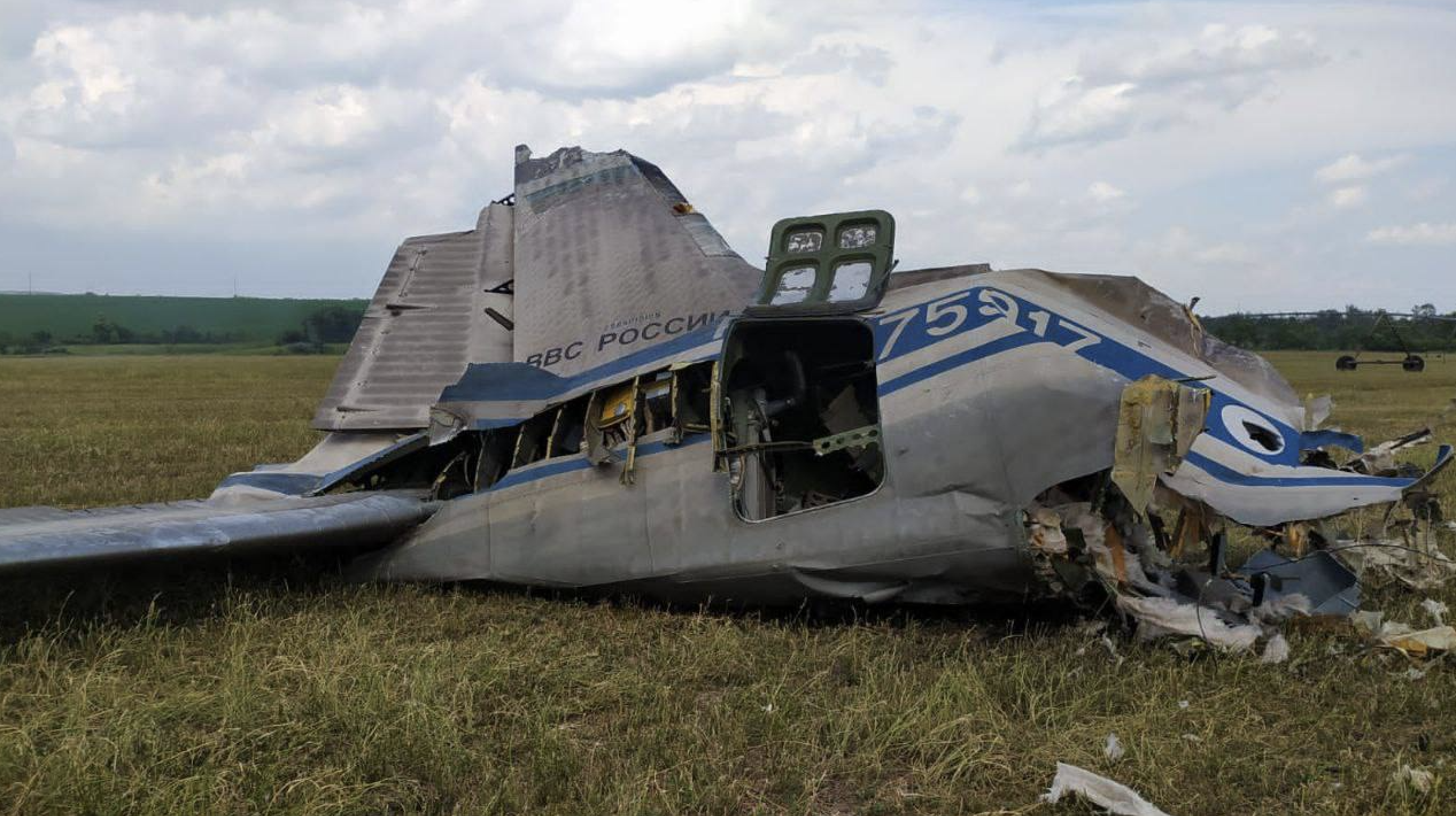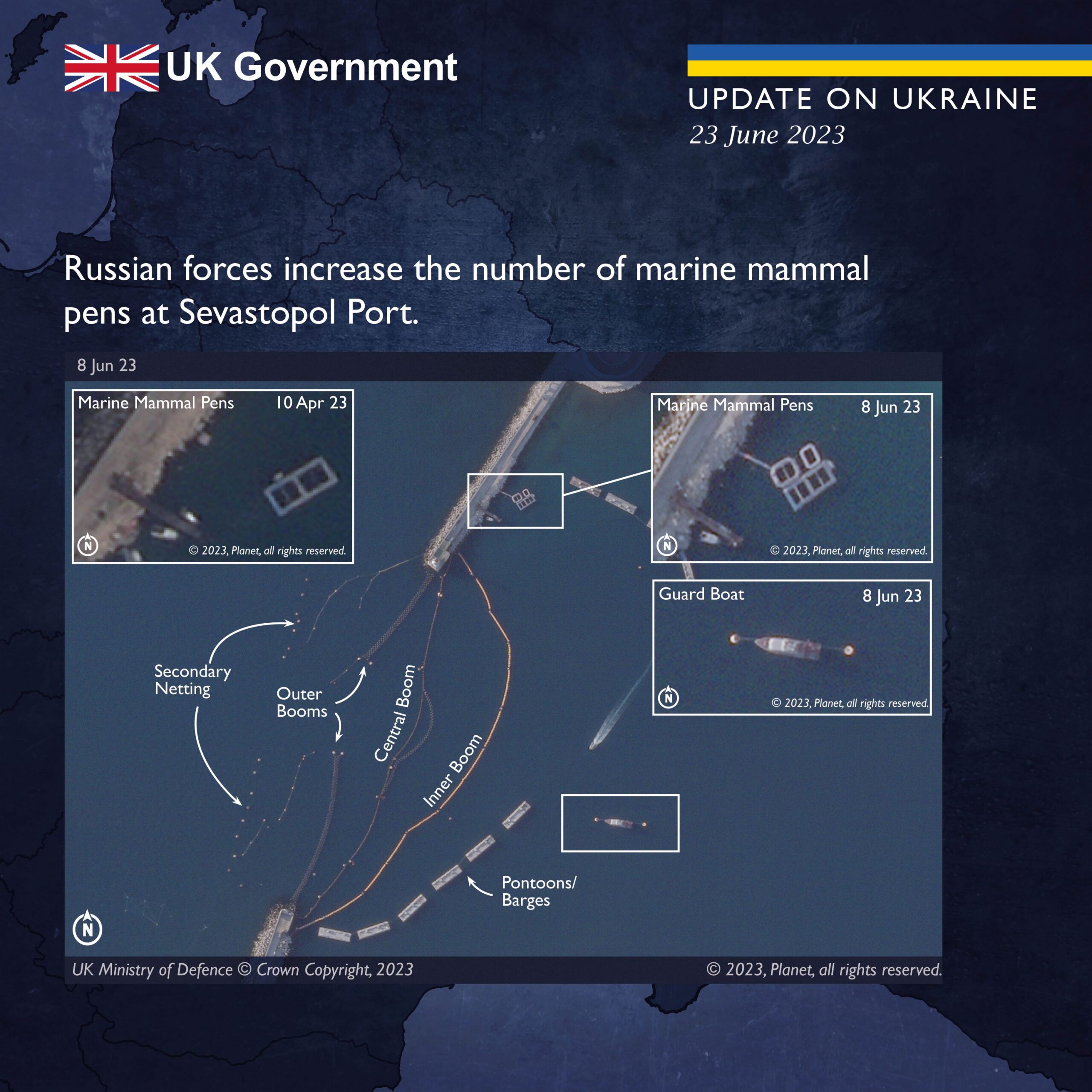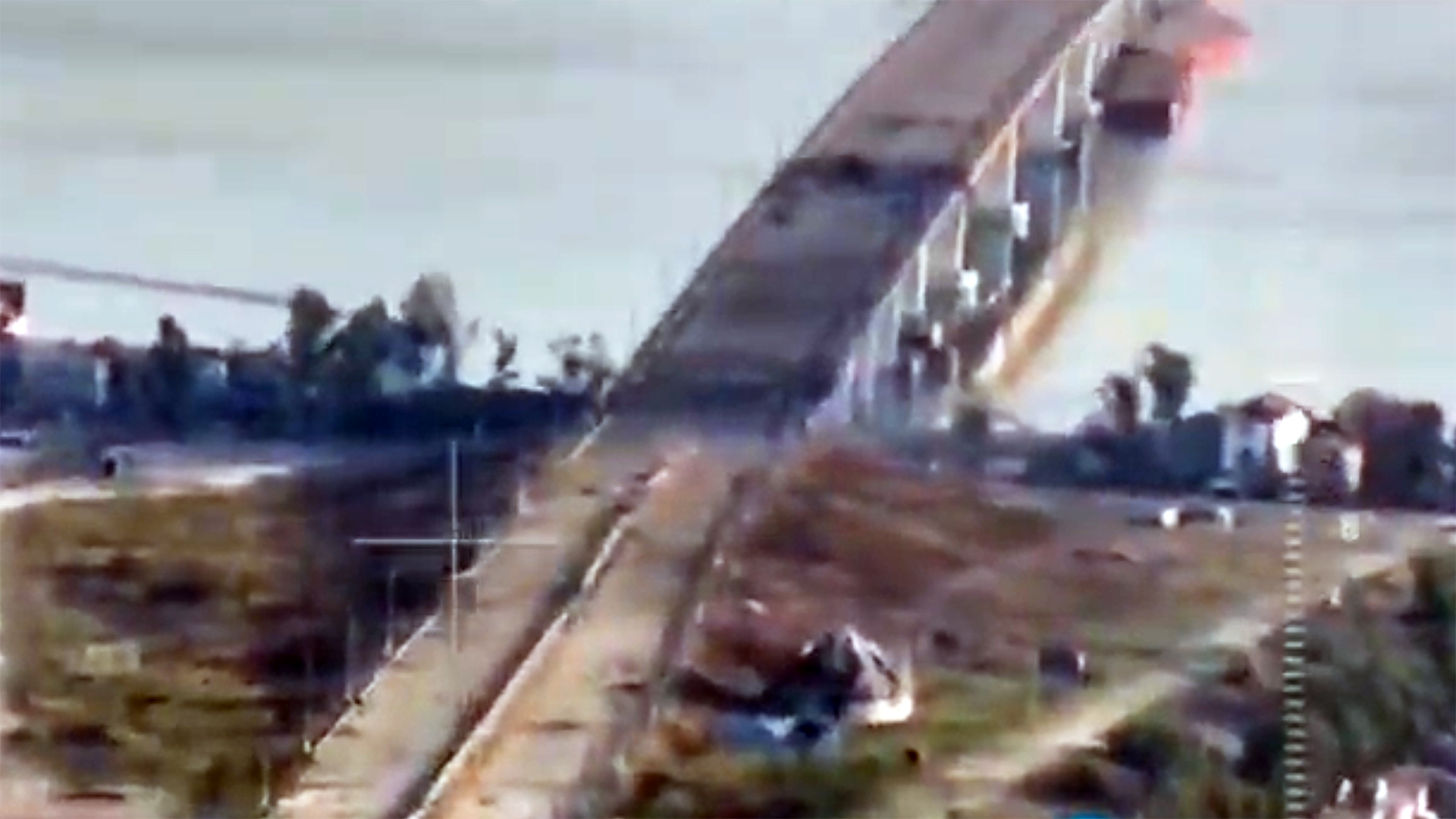While unconfirmed, there are increasing numbers of reports that the Ukrainian Armed Forces may be making significant gains around the notorious Antonovsky Bridge, which spans the Dnieper River in Kherson Oblast, southern Ukraine. Multiple Russian accounts on the Telegram messaging app claim that a group of around 100 Ukrainian fighters now have a bridgehead on the previously Russian-controlled left bank of the Dnieper and that they are now being supplied. Footage from here, seen in the tweet embedded below, purports to show a Russian BTR-82A armored personnel carrier firing while evacuating Russian soldiers under Ukrainian fire.
On Telegram, the Dva Mayora channel provided the following account of fighting around Antonovsky Bridge: “Antonovsky bridge, our (left) bank of the Dnieper. Kherson region. The enemy holds a small foothold on our bank for at least three days. The units of the Russian Armed Forces withdrew from the area, as the constant action of enemy artillery and SOF [special operations forces] created a threat of encirclement of our forces. They retreated with combat, neighboring units came to the rescue. As a result of the fighting, the Russian Armed Forces suffered losses.”
Dva Mayora further mentions that the Ukrainian contingent is being continuously supplied with materiel and its size is increasing. The same account adds that the Ukrainian Armed Forces is making use of high-speed boats as well as jamming systems to prevent Russian drone strikes. It’s also worth noting that the partially destroyed bridge would provide some cover from strikes.
There have since been apparent calls for Russian airstrikes, also posted to Telegram, in what would seem to be a desperate attempt to help break Ukraine’s increasing hold here.
The Antonovsky Bridge originally consisted of a box-girder bridge but it was repeatedly struck by Ukrainian fire starting last summer, with HIMARS rockets allegedly being used. The bridge was closed to passenger traffic before being supplemented by a pontoon bridge constructed by Russian forces on the eastern side of the bridge. In November last year, the Antonovsky Bridge suffered a partial collapse.
The Latest
In the aftermath of the Wagner mutiny over the weekend, more details have come to light about the heavy losses inflicted by on the Russian Aerospace Forces (VKS) by the mercenaries.
In addition to the six VKS helicopters that were shot down by Wagner, the private military company also destroyed one of the service’s precious Il-22M radio-relay aircraft. Video of the aircraft spiraling to the ground in flames appeared on Saturday, although some initial reports suggested it was an An-26 transport.
The aircraft reportedly fell victim to a Pantsir-S1 air defense system. Now there is photographic evidence of the wreckage, showing clearly that it was an Il-22M, which is based on the airframe of the 1950s-era Il-18 four-turboprop airliner. Prior to the loss, the VKS is thought to have had a maximum of 11 Il-22M radio-relay aircraft and a single Il-22K variant with a different equipment fit, although not all of these were likely operational at any given time. The loss of the Il-22M — and a reported 10 crew — is certainly a significant blow to the VKS.

The VKS helicopters reportedly destroyed also included three other electronic warfare platforms (plus another damaged): all examples of the Mi-8MTPR-1 that you can read more about here. These have also been important assets in the war in Ukraine, where they have provided jamming of air defense systems. The remaining losses comprised a single Mi-8 transport helicopter, a Mi-35M assault helicopter, and a Ka-52 attack helicopter, based on open-source evidence gathered by the Oryx blog.
From losing aircraft to losing artillery battles, and unconfirmed reports suggest that Russia is increasingly concerned that advanced counter-battery radars delivered to Ukraine by Western allies are making a big difference during the ongoing counteroffensive.
That counteroffensive has also seen the Ukrainian Armed Forces continue to liberate villages from Russian control, with one of the latest being Rivnopil, adjacent to a cluster of settlements that were recaptured in the southeast of the country earlier this month. The liberation of this latest settlement was announced today by Hanna Maliar, Ukraine’s deputy defense minister.
“Defense forces have brought Rivnopil back under our control. We are moving ahead,” Maliar wrote on the Telegram messaging app. Maliar has also claimed that around 50 square miles of territory in the south of the country has been returned to Ukrainian control since the counteroffensive began.
Among the Western allies, Germany is meanwhile making efforts to address well-publicized ammunition shortages, both for its own artillery and to ensure a steady flow of munitions to Kyiv.
According to a report today in Der Spiegel, the German government is seeking to secure a long-term supply of ammunition for Kyiv, with a framework manufacturing agreement drawn up at the end of last week between the Rheinmetall company and the defense ministry.
The agreement covers 330,000 rounds of 155-milimeter ammunition, with Berlin paying around $65.5 million for an initial 20,000 rounds for Ukraine.
At the same time, Germany has announced that it will be boosting its military presence in the Baltic region, to better counter the potential Russian threat there. German Minister of Defense Boris Pistorius has said that the country is planning to send “several thousand troops” to be stationed permanently in Lithuania.
While there has inevitably been much attention on the fallout of the Wagner coup at the weekend, Russia has meanwhile continued its aerial bombardment of Ukraine, albeit at a reduced level compared to previous weeks.
Suspilne, the Ukrainian state broadcaster reported that Russia attacked Ukraine overnight from the south, launching three Kalibr cruise missiles and eight Shahed drones. Ukrainian air defenses downed two missiles and seven drones, according to the same source. Another four drones are said to have been launched from the north, all of them being shot down.
While there have been recent reports on the losses sustained so far by Ukraine’s U.S.-supplied M2 Bradley infantry fighting vehicles (IFVs), the following video shows, in very graphic detail, how one unfortunate soldier stepped out of one of these vehicles and directly onto a mine. Viewer discretion is highly recommended.
According to a recent New York Times report, citing a Pentagon source, Ukraine has lost 17 out of 113 M2 Bradley ODS-SA vehicles delivered. Not all of these vehicles — accounting for roughly 15 percent of total deliveries to Ukraine — were destroyed, with some having been abandoned during the counteroffensive.
More evidence is coming to light of other Ukrainian armored vehicles taking losses, apparently also in the counteroffensive, although the date of the footage seen below is unconfirmed. The video appears to show two unidentified Ukrainian Armed Forces mine-resistant ambush protected (MRAP) vehicles being knocked out by a Russian T-80 main battle tank.
The latest Australian defense package for Ukraine was unveiled today, valued at around US$73 million.
“This latest package of support demonstrates that Ukraine can count on Australia,” Australian Prime Minister Anthony Albanese said. “We support international efforts to ensure Putin’s aggression fails and that Ukraine’s sovereignty and territorial integrity prevails,” he added.
This package includes:
- 70 military vehicles, among them: 28 M113 armored vehicles, 14 Special Operations Vehicles, and 28 MAN 40M medium trucks and 14 trailers.
- Supply of 105mm artillery ammunition.
While we address the latest developments in the training of Ukrainian pilots to fly F-16 fighters elsewhere on the The War Zone today, the U.K. Ministry of Defense today provided an update on the numbers of Ukrainians that have so far been trained in the United Kingdom and by other allies for other roles. In the last year, 17,000 Ukrainian recruits have been trained under Operation Interflex, the U.K. Ministry of Defense said, according to AFP.
Each of those recruits underwent a five-week program that has been carried out by the United Kingdom as well as nine partner nations: Canada, Australia, New Zealand, Norway, Finland, Sweden, Denmark, Lithuania, and the Netherlands.
Most of the recruits that passed through Interflex had little to no previous military experience.
“The determination and resilience of the Ukrainian recruits that arrive on British soil, from all walks of life, to train to fight alongside our British and international forces, is humbling to witness,” the U.K. Defense Secretary, Ben Wallace, said.
“The U.K. and our international partners will continue to provide this vital support, helping Ukraine defend against Russian aggression, for as long as it takes.”
By 2024, it’s planned that Operation Interflex will have trained around 30,000 recruits.
In an exclusive interview with The Guardian, Col. Gen. Oleksandr Syrskyi, Ukraine’s Ground Forces commander, said Ukraine has yet to commit the bulk of its forces to the counter-offensive.
The Guardian reported that the Ukrainian military built 12 new brigades from scratch for the offensive, nine of which have been equipped by Western allies, as we have noted in the past. Only three are believed to have been committed to battle so far.
“Everyone wants to achieve a great victory instantly and at once,” Syrskyi told The Guardian. “And so do we. But we have to be prepared to have this process take some time because there are a lot of forces massed on each side, a lot of materiel, and a lot of engineered obstacles. Our main force has not been engaged in fighting yet, and we are now searching, probing for weak places in the enemy defenses. Everything is still ahead.”
The fight, he acknowledged, has been far from easy.
“It’s difficult, stressful,” he says of the latest developments on the frontline, the newspaper reported.
Russia has been pursuing its own offensives near the town of Kreminna in the Luhansk region in the east of the country, while on Tuesday there was “hard fighting” in the Serebryansky forest, on the border of the Donetsk region, he says.
The Kremlin has moved units such as the 83 assault paratrooper brigade to Bakhmut from the south, he says, after the breaching of the Kakhovka dam in the southerly Kherson region made the passing of the Dnipro River — which would be necessary for Ukraine to liberate the remaining occupied territory there — even more daunting.
“The Russians are trying to seize the initiative, so the situation is really difficult,” Syrskyi said. “We must not underestimate the enemy,” he says. “The enemy has anticipated and continues to anticipate the most dangerous directions of our movements, and builds up strong defenses there that are quite difficult to penetrate.”
A Chinese company – previously sanctioned by the U.S. for providing support to Iran — shipped enough smokeless powder to Russia last year to make at least 80 million rounds of ammunition, The New York Times reported Friday.
“These previously unreported shipments, which were identified by Import Genius, a U.S.-based trade data aggregator, raise new questions about the role China has played in supporting Russia as it fights to capture Ukrainian territory,” the newspaper reported. “U.S. officials have expressed concerns that China could funnel products to Russia that would help in its war effort — what is known as ‘lethal aid’ — though they have not said outright that China has made such shipments.
The U.K. Defense Ministry on Friday confirmed prior reporting by our friend @CovertShores over at Naval News about Russia boosting its cadre of military-trained bottle-nosed dolphins at the frequently attacked Crimean port city of Sevastopol, home of the Black Sea Fleet.
On June 14, Naval News reported that “Russia appears to have doubled the trained dolphins defending Sevastopol naval base in Crimea. This is part of a gradual tightening of defenses in response to Ukraine’s growing ability to reach the strategic city. Despite the wider focus on missiles and maritime drones, Russia evidently takes the threat of Ukrainian special forces seriously.”
In a Tweet thread Friday, the U.K. MoD concurred with USNI’s assessments, albeit with somewhat fewer details. USNI, for instance, suggested, “that the number of animals has increased from 3-4 to 6-7.” The U.K. MoD didn’t offer specific numbers but did share satellite imagery as proof of the increase in sea mammal pens.
The Russians began deploying trained dolphins to Sevastopol last year, UNSI reported at the time.
According to the U.K. MoD, “imagery shows a near doubling of floating mammal pens in the harbor which highly likely contain bottle-nosed dolphins.”
But dolphins aren’t the only aquatic mammals Russia uses for military purposes, according to the MoD.
“In Arctic waters, the navy also uses Beluga whales and seals,” the MoD noted. “Russia has trained animals for a range of missions, but the ones housed in Sevastopol harbor are highly likely intended to counter enemy divers.”

In developing tranches of military aid for Ukraine, U.S. officials have frequently talked about the value of armor for maneuver. This video below shows how that’s come into play as Ukrainian troops riding in High Mobility Multipurpose Wheeled Vehicles (HMMWV) were able to shoot, move, and survive anti-personnel mines.
Ukrainian artillery also continues to extract a heavy toll on the Russian Armed Forces. Case in point, this apparently recent video that shows the last moments of a massive 240mm 2S4 Tyulpan heavy self-propelled mortar:
Ukrainian drones, too, remain widely employed in coordinating attacks on Russian forces, as in this engagement, in the Bakhmut area. Ukrainian forces from the 56th Motorized Infantry Brigade reportedly used a drone to locate a Russian Strela-10 (SA-13 Gopher) short-range air defence system, before calling in a strike that is said to have used a M30A1 GMLRS rocket.
Bakhmut, of course, became associated with some brutal trench warfare earlier in the conflict, and the video below suggests that combat of this type is very much ongoing in the region. Although we don’t have a particular date for this footage, it appears to have only recently emerged.
While we have seen Ukrainian soldiers riding monowheels in at least one previous video (apparently filmed on or near the frontlines), this latest offering suggests that this unorthodox mode of transport might be subject to a wider uptake. Unfortunately, we don’t have any details as to when or where this video was taken.
And finally, amid the horrors of war, one Ukrainian soldier found a moment of peace with the latest animal mascot, the combat kitty.
That’s it for now. We’ll update this story when there’s more news to report about Ukraine.
Contact the author: howard@thewarzone.com
